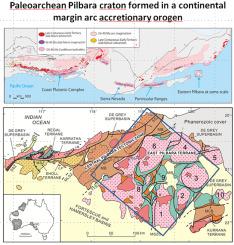Earth-Science Reviews ( IF 12.1 ) Pub Date : 2021-06-30 , DOI: 10.1016/j.earscirev.2021.103725 Timothy Kusky , Brian F. Windley , Ali Polat , Lu Wang , Wenbin Ning , Yating Zhong

|
Determining whether plate tectonics or some other mode of planetary dynamics operated in the early Archean is one of the most contentious and debated areas of Earth Sciences today. The Paleo- Mesoarchean dome-and-basin structures of the Eastern Pilbara craton are widely used as an example of an early Archean terrane supposedly unlike any produced by plate tectonics in the current mode of active-lid plate tectonics on Earth. In contrast, we produce a synthesis of the structural, magmatic and sedimentological development of the Eastern Pilbara craton from 3600 to 2800 Ma, and through comparative tectonic analysis, show that the craton developed following a typical orogenic sequence from an immature oceanic arc-dominated accretionary orogen, with the oldest rocks of the craton represented by slabs of primitive circa 3590 Ma gabbro - anorthosite - ultramafic rocks, and 3522–3426 Ma oceanic crust and overlying dominantly hydrothermal deep-water cherts imbricated in thrust piles and giant recumbent nappes. These were intruded by juvenile arc magmas including gabbros, diorites, and TTG suites, most of which intruded as sills into structurally favorable sites between 3484 and 3416 Ma. These oceanic crust and overlying sedimentary litho-tectonic assemblages of gabbro/ basalt/ komatiite/ chert, and TTG-diorite-dominated plutonic rocks were deformed into imbricate and antiformal thrust stacks intruded by suites of sheet-like TTG magmas during late regional shortening-related deformation at 3318–3290 Ma, then soon-after, folded by upright folds during continued contractional deformation. The intrusive style, compositions, and relationships to structures suggest that the late magmatic suites represent a massive slab-failure magmatic event similar to those formed during arc accretion and slab failure events in the North and South American Cordilleras, and older orogens of all ages. Late-orogenic shortening deformed these sheet intrusions into large domal structures, synchronous with or soon-after late- to post-orogenic cross-cutting steep-walled circa 3274–3223 Ma plutons vertically intruded the cores of some of the domes, forming nested plutons akin to the Cretaceous Sierra Crest Suite of the Sierra Nevada batholith, and deformed equivalents in Phanerozoic orogens. In a much younger magmatic event, a wide swath of the craton was affected by circa 2851–2831 monzogranite intrusions, after which the magmatic events of the Archean of the Eastern Pilbara were terminated by the circa 2772 Ma Black Range dolerite dike swarm, that preserves evidence for rapid APW drift during its intrusion.
The Eastern Pilbara represents only a very small preserved Paleo-Mesoarchean crustal remnant, measuring a mere 200 × 200 km2, yet has been frequently used to model the presumed tectonic behavior of the entire planet for much of the Archean. In this synthesis, we show that the scale of the craton renders its significance in this literature greatly exaggerated. The Eastern Pilbara is only 1/3 the size of just the Sierra Nevada batholith. Considering the entire Eastern, Central and Western Pilbara belts, the scale and tectonic zonation of lithotectonic assemblages is remarkably similar to that of the California section of the North American Cordillera, from arc root (Eastern Pilbara. cf. Sierra Nevada), to fore-arc overlap basin (de Gray Basin, cf. Great Central Valley Sequence), to an accretionary complex (Western Pilbara, cf. Franciscan). The duration of different magmatic and deformational events, confined to three main pulses in 300 Ma, including about six total magmatic suites over 500 Ma, is similar to that of different pulses and/or accretionary events in the western American Cordilleran examples, such as the peri-Gondwanan Famatinian (Cambro-Ordovician) and Pampean (Cambrian) arcs which were later affected by Permian and Mesozoic intrusives from the Peruvian coastal batholith, and form part of the present day active Andean margin of South America.
From this analysis, we firmly conclude from four degrees of similarity of the full data set of field, structural, temporal, and compositional data that the evolution of the craton is readily and rather simply explained by the plate tectonic paradigm. Thus there is no scientific justification to suggest that the geological characteristics of the Eastern Pilbara require any different imaginative or fantastic type of planetary heat loss mode during the interval of its formation from 3600 to 2800 Ma. The Eastern Pilbara is simply an exceptionally well-preserved small fragment of a poly-phase root of a continental margin accretionary orogen that evolved from accretion and magmatism from some of Earth oldest telescoped oceans and included arcs, in a regime of accretionary-style plate tectonics. Comparison with other well-preserved Eo-Mesoarchean terranes shows a common trait, that of derivation from immature introceanic accretionary orogens, building Earth's first continents.
中文翻译:

在增生造山带的洋内和大陆边缘弧的生长和死亡过程中形成太古代穹顶和盆地式结构
确定在太古代早期是否存在板块构造或其他一些行星动力学模式是当今地球科学中最具争议和争论的领域之一。东皮尔巴拉克拉通的古中太古代穹顶和盆地结构被广泛用作早期太古代地体的一个例子,据推测,这与地球上当前活动盖板块构造模式中的板块构造产生的任何构造不同。相比之下,我们对东皮尔巴拉克拉通从 3600 到 2800 Ma 的结构、岩浆和沉积学发展进行了综合,并通过比较构造分析表明,克拉通是按照典型的造山序列从未成熟的海洋弧主导的增生岩发育而来的。造山带,克拉通最古老的岩石以大约 3590 Ma 的原始辉长岩-斜长岩-超镁铁质岩板和 3522-3426 Ma 的大洋地壳和覆盖在冲断桩和巨大横卧推覆岩中的以热液为主的深水燧石为代表。这些被幼年弧岩浆侵入,包括辉长岩、闪长岩和 TTG 岩层,其中大部分作为基岩侵入 3484 至 3416 Ma 之间的构造有利位置。这些洋壳和上覆辉长岩/玄武岩/科马提岩/燧石的沉积岩-构造组合,以及以TTG闪长岩为主的深成岩,在晚期区域缩短相关的过程中,被成套片状TTG岩浆侵入,变形为叠瓦状和反形式逆冲叠层。在 3318-3290 Ma 变形,然后不久之后,在持续收缩变形期间被直立褶皱折叠。侵入性的风格、成分和与结构的关系表明,晚期岩浆组代表了一个大规模的板块破裂岩浆事件,类似于在北美和南美科迪勒拉山脉以及所有年龄的较老造山带中的弧形增生和板块破裂事件期间形成的那些岩浆事件。造山后期的缩短使这些片状侵入体变形为大型穹窿结构,与大约 3274-3223 Ma 的晚期至后造山横切陡壁岩体同步或不久之后,岩体垂直侵入一些穹窿的核心,形成嵌套的岩体类似于内华达山脉基岩的白垩纪 Sierra Crest Suite,以及显生宙造山带中的变形等效物。在一个更年轻的岩浆事件中,克拉通的大片区域受到了大约 2851-2831 年二长花岗岩侵入的影响,
东皮尔巴拉仅代表一个非常小的保存下来的古中太古代地壳遗迹,尺寸仅为 200 × 200 km 2,但已经常用于模拟整个行星的大部分太古代的假定构造行为。在这个综合中,我们表明克拉通的规模使其在该文献中的重要性被大大夸大了。东皮尔巴拉仅是内华达山脉基石的 1/3。考虑到整个东、中、西皮尔巴拉带,岩石构造组合的规模和构造带与北美科迪勒拉的加利福尼亚部分非常相似,从弧根(东皮尔巴拉,参见内华达山脉)到前缘。弧重叠盆地(德格雷盆地,参见大中央谷层序),到增生复合体(西皮尔巴拉,参见方济会)。不同岩浆和变形事件的持续时间,仅限于 300 Ma 的三个主要脉冲,
从这一分析中,我们从场、结构、时间和成分数据的完整数据集的四个相似度确定地得出结论,克拉通的演化很容易并且相当简单地由板块构造范式解释。因此,没有科学依据表明东皮尔巴拉的地质特征在 3600 至 2800 Ma 的形成间隔期间需要任何不同的想象或奇特类型的行星热损失模式。东皮尔巴拉只是一个大陆边缘增生造山带的多相根部的一个保存异常完好的小碎片,它是从地球最古老的望远镜海洋的增生和岩浆作用演化而来的,包括在增生式板块构造体系中的弧.


























 京公网安备 11010802027423号
京公网安备 11010802027423号